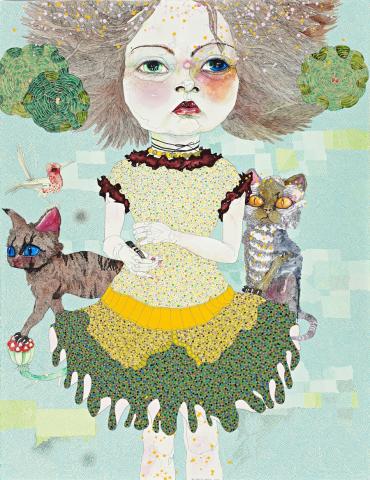KEEPER OF THE POLKA-DOTTS, 2004
DEL KATHRYN BARTON
synthetic polymer paint, watercolour and ink on canvas
220.0 x 170.5 cm
signed and dated lower centre: del kathryn barton 2004
signed, dated and inscribed with title verso
Ray Hughes Gallery, Sydney
Company collection, Melbourne
Del Kathryn Barton is represented by Karen Woodbury Gallery, Melbourne and Roslyn Oxley9 Gallery, Sydney
Awarded the prestigious Archibald Prize in 2008 for You are what is most beautiful about me, a tender self-portrait with her two children Kell and Arella, Del Kathryn Barton is undoubtedly one of the most critically acclaimed, eagerly sought-after figures in Australian contemporary art. Bearing affinities with elements of Pop Art and Surrealism, including the eroticised poupèes of Hans Bellmer, her richly illustrative work offers a complex, often disorienting meditation upon the dichotomous nature of beauty which, by highlighting both its sensual and abject dimensions, seeks to undermine simplistic notions of the feminine. Not surprisingly perhaps, Barton also references the contradictions inherent in society's celebration of female beauty through the shallow space of fashion - its collapse of life into a pose and collapse of character into a decorative appearance. For all their contemporary fashion allusions however, Barton's lithe figures also seem strangely of another time - their 'big, overstated eyes recalling the feminine vapid, doe-eyed cuteness in Japanese manga or the unearthly gaze often found in naive art.'1
Monumental in scale and painstaking embellishment, Keeper of the Polka-Dotts 2004 not only indulges Barton's fascination with the world of children, but continues her enduring preoccupation with the female face as a repository of thoughts, emotions and fantasies. Occupying an imaginary realm adorned with tiny flourishes of foliage, uncanny creatures and wildly chaotic patterns, the work betrays a compulsive beauty in its infinitely rendered detail. Yet if alluding to the imaginary, naive world of children, at the same time the direct, steady gaze of the sitter implies a certain knowingness or wisdom - indeed, what does she reveal with her overblown face and simultaneously conceal with her innocent stare? Appealing to the basic human impulse to imagine the character behind a face, thus the image both delights and beguiles in its disconcerting fluidity between real and imaginary, representation and subjectivity. Moreover, with the animals depicted evoking the duality of the human psyche - what seems cute and benign can also be carnal and predatory - the composition thus continues the artist abiding preoccupation with the effect of nature upon humankind's physiological and metaphysical existence. As Barton reflects, 'The animal psyche retains dualities that hold seemingly impenetrable mysteries... mysteries pertaining to lives lived in an elemental, instinctive immediacy that the contemporary human no longer shares on that physical level.'2
1. Colless, E., 'Del Kathryn Barton', Australian Art Collector, vol 38, October-December 2006, p. 130
2. Del Barton cited in Barker, C., 'Basic Instinct: Rabbit Protectors and Pussy Lovers', Oyster Magazine, vol 43, December-January 2003.
VERONICA ANGELATOS
